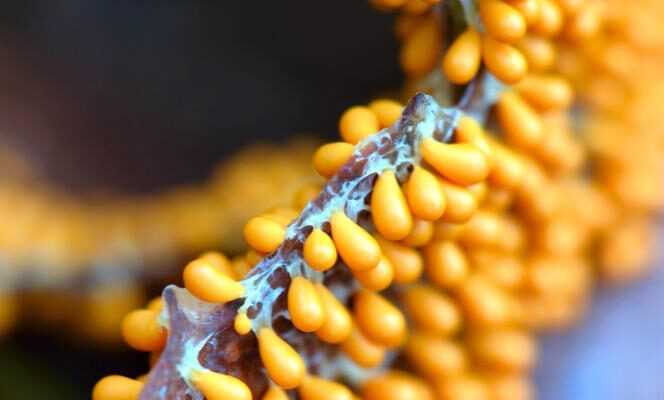2021: blobs in stock
During his flight, Thomas Pesquet shared SpaceX’s capsule with four species of slime mold Physarum polycephalum, better known as blobs. Without eyes or mouths, these yellow, spongy-looking organisms fascinate scientists with their intelligence. Getting out of a labyrinth, memorizing a route or hibernating for protection, the blob can (almost) do anything. The French astronaut will test their abilities in space. On Earth, 2,000 classes, from elementary to high school, will conduct similar experiments to compare their results. The opportunity to arouse vocations.
2014: geckos K.-O.
This is another type of experiment that scientists subjected five geckos, also called lizards, to studying the effects of gravity on their sex lives. The fate of these reptiles native to Mauritius went around the world when Russian scientists announced that they had lost control of the Foton-M4 satellite, launched on July 19, 2014. The team is stepping up its efforts to find it. Alas, no gecko survived the trip. Unlike the flies that have accompanied them, and have reproduced without worry.
2007: bold tardigrades
Small but strong, the tardigrade, a multicellular animal about a millimeter long, is able to survive in very hostile environments. Until the void of space. On board the Russian Soyuz rocket, scientists wanted to test their abilities in the name of science. Because in space, a vacuum boils the internal water of beings and ultraviolet radiation destroys DNA. Surprise: the majority of tardigrades survived, going so far as to repair their own DNA. The secret of their resistance? A protein called Dsup. What to contribute to research on cell therapies.
1963: heroic pussy
The first French animal sent into the air was named Félicette, a calm cat with a two-tone coat. The myth would have it that the candidate initially selected – a male, Felix – would have fled before his mission. Félicette is, to this day, the only cat to have made a round trip in space. If she survives her feat, her name will also be among the victims of science. She ended up euthanized and dissected on her return to earth. But, in 2019, a bronze statue with his effigy, erected at the International Space University in Strasbourg, finally pays homage to him. Very close to the bust of Russian cosmonaut Yuri Gagarin.
1957: pioneer bitch
Laïka, 3, inaugurated the first manned space flight, sent by the Soviet Union. A short-lived success because the canine died just seven hours after take-off. At issue: a failure in the temperature regulation system. The outcome of the trip would have been fatal to the little dog anyway. No return to Earth was possible for the animal, sent into Earth orbit. Sputnik II then becomes his celestial tomb, before being consumed in the atmosphere nine months later. But if Gagarin was able to achieve his first orbital flight sixty years ago, it is thanks to Laïka.
